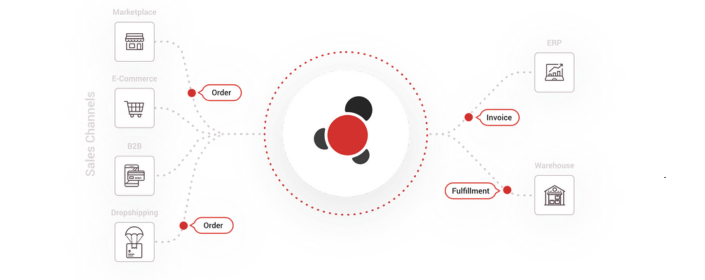Be first to know
Keep up to date with ecommerce news, trends and articles. Brought to you by Stock2Shop.
Sign up todaySelling across multiple channels is increasingly becoming the rule rather than the exception. Businesses that once relied solely on a brick-and-mortar presence are now supplementing — or even replacing — that model with online stores, marketplaces and B2B trade portals. This shift offers customers more convenience and businesses more opportunities for growth.
But with greater reach comes greater complexity. Managing inventory and pricing across multiple channels is no small task. That’s why Stock2Shop exists — to integrate your ERP (enterprise resource planning system) with all your sales channels, ensuring that your ERP remains the source of truth for stock levels, pricing and other important data.

While syncing inventory and pricing from the ERP outward is essential, the other side of the equation is often overlooked: syncing orders back into the ERP. Some businesses choose a one-way sync, allowing product and stock updates to flow to sales channels but not bringing orders back in. On the surface, manually processing orders in bulk at the end of each day can seem like a simpler option, but in practice, it exposes the business to significant risks that can undermine the very benefits of omnichannel selling.
Let’s explore why order syncing is critical, and the dangers of neglecting it.
At its core, order syncing ensures that when a customer buys a product from any of your sales channels, that order is automatically pushed into your ERP in near real-time. This simple step provides several mission-critical benefits:
The primary purpose of integrating your ERP with your sales channels is to keep inventory accurate everywhere. Without syncing orders, your ERP doesn’t immediately know that stock has been reduced. As a result, the ERP continues to broadcast inflated stock levels to other channels. This means a product that just sold out on one website may still appear available on your B2B portal or another marketplace.
The outcome? Overselling — a situation where multiple customers buy the same item that you can’t actually fulfill. Overselling damages your brand reputation, creates costly refund processes, and can even result in penalties from certain marketplaces.
Manually capturing orders from online sales channels into your ERP is not only time-consuming but also prone to human error. Transcription mistakes, delays or overlooked orders can cause serious fulfillment problems. Automated order syncing eliminates these risks, ensuring every order is correctly captured, processed and tracked without requiring extra staff hours.
When all orders flow into the ERP, you build a single, consolidated view of your sales activity. This improves reporting, forecasting and customer service. For example, if a B2B client calls to ask about their order, your staff can see the full picture in the ERP without needing to check individual platforms.
Having all orders in one place provides valuable insights into product performance, channel effectiveness and seasonal demand trends. This intelligence is vital for planning stock purchases, adjusting pricing strategies and managing promotions. Without synced orders, data is fragmented across systems, reducing visibility and making business decisions less accurate.
Now let’s look at what can go wrong when businesses opt for a one-way sync and leave orders out of the integration.
As mentioned, overselling is one of the biggest risks. Let’s say you have five units of a product. A customer buys three on your online store, but because the order isn’t synced, your ERP still thinks you have five. A second customer then buys two on your marketplace. On paper everything looks fine, but in reality, you’re out of stock, and the second customer’s order cannot be fulfilled.
This leads to negative customer experiences, potential loss of repeat business, and damage to your brand’s credibility. On platforms like Amazon or Takelaot, overselling can even affect your seller rating and eligibility to continue trading.
Without order syncing, the only way to prevent overselling is to ringfence stock into channel-specific virtual warehouses. Not only is this labour-intensive, you now run the risk of underselling. This is because your various sales channels aren’t drawing stock availability from the same centralised source of truth. Your website could therefore sell out of a particular product and, not knowing that there is plenty of stock in a different virtual warehouse, lose out on potential sales.
Without synced orders, staff need to manually import, export, or reconcile sales data from multiple channels. This eats up valuable time and introduces room for mistakes. As order volumes grow, the workload increases exponentially, creating bottlenecks in your fulfillment process.
When orders aren’t immediately visible in the ERP, your finance team operates with incomplete data. This can delay invoicing, impact credit control and create confusion about revenue streams. Having orders automatically integrated into the ERP ensures that the financial impact of every sale is captured instantly.
Forecasting relies on accurate, up-to-date data about what’s selling, where, and in what volumes. If orders from some channels don’t flow into the ERP, your team is essentially planning blind. This can lead to over-purchasing (tying up cash in excess inventory) or under-purchasing (leading to stockouts and missed sales).
Manual order handling may seem manageable when you’re receiving a handful of online sales per day. But as your business grows, so does the complexity. Without automated syncing, scaling becomes painful, requiring additional headcount and processes that could have been avoided with proper integration from the start.

The essence of omnichannel retailing is consistency — customers expect accurate information, seamless transactions and reliable service, regardless of where they buy from you. Stock2Shop helps companies achieve this by keeping the ERP as the single source of truth, broadcasting updates to all channels in near real-time.
But for this system to work properly, order syncing is non-negotiable. Without it, the feedback loop is broken, and the ERP is blind to what’s actually happening in your sales environment.
Get in touch, and find out how Stock2Shop can help you reach more customers and streamline your processes.

Keep up to date with ecommerce news, trends and articles. Brought to you by Stock2Shop.
Sign up todayUnderstanding product data is essential for a successful ecommerce business. Here’s an overview of the most important elements of product data you need to understand.
Read MoreCategorising products correctly is a major pain point for many ecommerce websites. Layered navigation is the solution: find out how – and why – to implement it
Read MoreWant to find out exactly how Stock2Shop can make your business more efficient and streamlined?
Contact Us